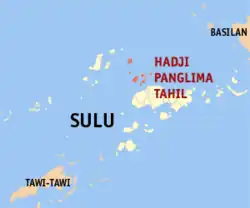Hadji Panglima Tahil
حدجي ڤڠليما تحيل Marungas | |
|---|---|
| Municipality of Hadji Panglima Tahil | |
 | |
 Seal | |
 Map of Sulu with Hadji Panglima Tahil highlighted | |
OpenStreetMap | |
.svg.png.webp) Hadji Panglima Tahil Location within the Philippines | |
| Coordinates: 6°10′N 120°55′E / 6.17°N 120.92°E | |
| Country | Philippines |
| Region | Bangsamoro Autonomous Region in Muslim Mindanao |
| Province | Sulu |
| District | 1st district |
| Barangays | 5 (see Barangays) |
| Government | |
| • Type | Sangguniang Bayan |
| • Mayor | Moh. Mustafa S. Burahan |
| • Vice Mayor | Galib K. Datan |
| • Representative | Samier A. Tan |
| • Municipal Council | Members |
| • Electorate | 5,324 voters (2022) |
| Area | |
| • Total | 67.90 km2 (26.22 sq mi) |
| Elevation | 14 m (46 ft) |
| Highest elevation | 788 m (2,585 ft) |
| Lowest elevation | 0 m (0 ft) |
| Population (2020 census)[3] | |
| • Total | 7,906 |
| • Density | 120/km2 (300/sq mi) |
| • Households | 1,372 |
| Economy | |
| • Income class | 6th municipal income class |
| • Poverty incidence | 78.45 |
| • Revenue | ₱ 58.08 million (2020) |
| • Assets | ₱ 152.8 million (2020) |
| • Expenditure | ₱ 56.15 million (2020) |
| • Liabilities | ₱ 122.6 million (2020) |
| Service provider | |
| • Electricity | Sulu Electric Cooperative (SULECO) |
| Time zone | UTC+8 (PST) |
| ZIP code | 7413 |
| PSGC | |
| IDD : area code | +63 (0)68 |
| Native languages | Tausug Tagalog |
| Website | www |
Hadji Panglima Tahil, officially the Municipality of Hadji Panglima Tahil (Tausūg: Kawman sin Hadji Panglima Tahil; Tagalog: Bayan ng Hadji Panglima Tahil), is a 6th class municipality in the province of Sulu, Philippines. According to the 2020 census, it has a population of 7,906 people.[3]
It is formerly known as Marunggas.
As of 2000, it was the poorest municipality in the Philippines with a poverty incidence estimate of 89.7%.[5]
Geography
Barangays
Hadji Panglima Tahil is politically subdivided into 5 barangays. Each barangay consists of puroks while some have sitios.
- Bangas (Poblacion)
- Bubuan
- Kabuukan
- Pag-asinan
- Teomabal
Climate
| Climate data for Hadji Panglima Tahil, Sulu | |||||||||||||
|---|---|---|---|---|---|---|---|---|---|---|---|---|---|
| Month | Jan | Feb | Mar | Apr | May | Jun | Jul | Aug | Sep | Oct | Nov | Dec | Year |
| Mean daily maximum °C (°F) | 27 (81) |
27 (81) |
27 (81) |
28 (82) |
29 (84) |
29 (84) |
28 (82) |
28 (82) |
28 (82) |
28 (82) |
28 (82) |
28 (82) |
28 (82) |
| Mean daily minimum °C (°F) | 27 (81) |
26 (79) |
27 (81) |
27 (81) |
28 (82) |
28 (82) |
28 (82) |
28 (82) |
28 (82) |
28 (82) |
28 (82) |
27 (81) |
28 (81) |
| Average precipitation mm (inches) | 170 (6.7) |
130 (5.1) |
125 (4.9) |
122 (4.8) |
229 (9.0) |
286 (11.3) |
254 (10.0) |
248 (9.8) |
182 (7.2) |
257 (10.1) |
233 (9.2) |
188 (7.4) |
2,424 (95.5) |
| Average rainy days | 18.3 | 15.3 | 15.2 | 14.6 | 22.8 | 24.0 | 24.3 | 23.3 | 20.5 | 22.6 | 21.9 | 19.3 | 242.1 |
| Source: Meteoblue (modeled/calculated data, not measured locally)[6] | |||||||||||||
Demographics
| Year | Pop. | ±% p.a. |
|---|---|---|
| 1903 | 267 | — |
| 1918 | 4,296 | +20.35% |
| 1939 | 1,998 | −3.58% |
| 1948 | 1,850 | −0.85% |
| 1960 | 671 | −8.10% |
| 1970 | 1,341 | +7.16% |
| 1975 | 4,178 | +25.60% |
| 1980 | 4,325 | +0.69% |
| 1990 | 4,153 | −0.41% |
| 1995 | 4,419 | +1.17% |
| 2000 | 5,314 | +4.03% |
| 2007 | 6,192 | +2.13% |
| 2010 | 5,850 | −2.05% |
| 2015 | 6,375 | +1.65% |
| 2020 | 7,906 | +4.32% |
| Source: Philippine Statistics Authority[7][8][9][10] | ||
Economy
Poverty Incidence of Hadji Panglima Tahil
References
- ↑ Municipality of Hadji Panglima Tahil | (DILG)
- ↑ "2015 Census of Population, Report No. 3 – Population, Land Area, and Population Density" (PDF). Philippine Statistics Authority. Quezon City, Philippines. August 2016. ISSN 0117-1453. Archived (PDF) from the original on May 25, 2021. Retrieved July 16, 2021.
- 1 2 Census of Population (2020). "Bangsamoro (BARMM)". Total Population by Province, City, Municipality and Barangay. Philippine Statistics Authority. Retrieved 8 July 2021.
- ↑ "PSA Releases the 2018 Municipal and City Level Poverty Estimates". Philippine Statistics Authority. 15 December 2021. Retrieved 22 January 2022.
- ↑ "NSCB - Press Release - NSCB releases poverty estimates for the country's 1,623 cities and municipalities". Archived from the original on 2007-07-01. Retrieved 2007-02-06.
- ↑ "Hadji Panglima Tahil, Sulu : Average Temperatures and Rainfall". Meteoblue. Retrieved 31 January 2019.
- ↑ Census of Population (2015). "ARMM – Autonomous Region in Muslim Mindanao". Total Population by Province, City, Municipality and Barangay. Philippine Statistics Authority. Retrieved 20 June 2016.
- ↑ Census of Population and Housing (2010). "ARMM – Autonomous Region in Muslim Mindanao" (PDF). Total Population by Province, City, Municipality and Barangay. National Statistics Office. Retrieved 29 June 2016.
- ↑ Censuses of Population (1903–2007). "ARMM – Autonomous Region in Muslim Mindanao". Table 1. Population Enumerated in Various Censuses by Province/Highly Urbanized City: 1903 to 2007. National Statistics Office.
{{cite encyclopedia}}: CS1 maint: numeric names: authors list (link) - ↑ "Province of Sulu". Municipality Population Data. Local Water Utilities Administration Research Division. Retrieved 17 December 2016.
- ↑ "Poverty incidence (PI):". Philippine Statistics Authority. Retrieved December 28, 2020.
- ↑ "City and Municipal Level Poverty Estimates; 2006 and 2009" (PDF). Philippine Statistics Authority. 3 August 2012.
- ↑ "2012 Municipal and City Level Poverty Estimates" (PDF). Philippine Statistics Authority. 31 May 2016.
- ↑ "Municipal and City Level Small Area Poverty Estimates; 2009, 2012 and 2015". Philippine Statistics Authority. 10 July 2019.
- ↑ "PSA Releases the 2018 Municipal and City Level Poverty Estimates". Philippine Statistics Authority. 15 December 2021. Retrieved 22 January 2022.
External links
Wikimedia Commons has media related to Hadji Panglima Tahil.
- Philippine Standard Geographic Code
- Hadji Panglima Tahil Profile at the DTI Cities and Municipalities Competitive Index
- Philippine Census Information
- Local Governance Performance Management System Archived 2016-03-04 at the Wayback Machine
This article is issued from Wikipedia. The text is licensed under Creative Commons - Attribution - Sharealike. Additional terms may apply for the media files.